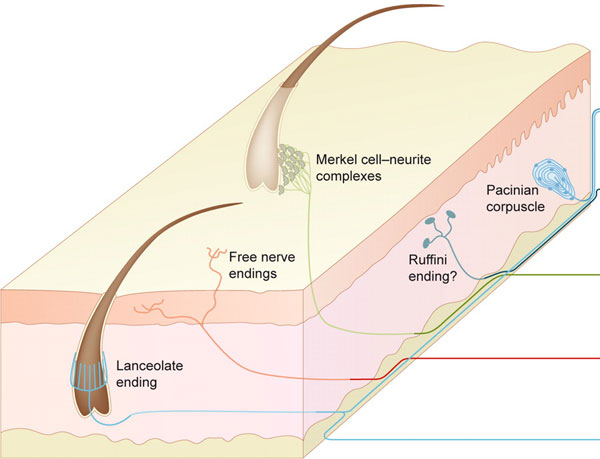File:Touch receptors in mammalian skin cartoon 01.jpg
Touch_receptors_in_mammalian_skin_cartoon_01.jpg (600 × 459 pixels, file size: 38 KB, MIME type: image/jpeg)
Touch Receptors in Mammalian Skin
Touch-sensitive afferents that innervate mammalian skin display morphological, functional, and developmental diversity. As shown, lanceolate endings, Merkel cell–neurite complexes, Ruffini endings, and free nerve endings innervate hairy skin. These receptors have unique neuronal outputs, making classification feasible by electrophysiological recording from intact tissue.
- Lanceolate endings
- rapidly adapting or down hair afferents.
- latter are exceptionally sensitive light-touch receptors that depend on Neurotrophin-4 for proper development (Stucky et al., 1998).
- Merkel cell–neurite complexes
- mediate slowly adapting type I (SAI) responses, which are characterized by an irregular firing pattern during sustained pressure (Wellnitz et al., 2010).
- Ruffini endings
- proposed to mediate stretch-sensitive slowly adapting type II (SAII) responses (Chambers et al., 1972).
- Although their presence in different species is debated,
- Developmental pathways have not yet been defined for these receptors.
- Free nerve endings
- abundantly innervate the epidermis
- include nociceptors and low-threshold C-fibers (Seal et al., 2009).
- Pacinian corpuscles
- lamellar vibration receptors that produce rapidly adapting responses.
- In glabrous skin of the palms and fingertips, Pacinian corpuscles, rapidly adapting Meissner’s corpuscles (not depicted), Merkel cell–neurite complexes, and free nerve endings make up the majority of touch receptors.
- Links: Image - Touch receptors 1 | Image - Touch receptors 2 | Touch Development | Integumentary Development | Neural Development
Reference
<pubmed>20956378</pubmed>| PMC2958478 | JCB
Copyright
Rockefeller University Press - Copyright Policy This article is distributed under the terms of an Attribution–Noncommercial–Share Alike–No Mirror Sites license for the first six months after the publication date (see http://www.jcb.org/misc/terms.shtml). After six months it is available under a Creative Commons License (Attribution–Noncommercial–Share Alike 4.0 Unported license, as described at https://creativecommons.org/licenses/by-nc-sa/4.0/ ). (More? Help:Copyright Tutorial)
Original file name: Figure 1. http://jcb.rupress.org/content/191/2/237/F1.large.jpg (cropped and resized from original image)
File history
Click on a date/time to view the file as it appeared at that time.
| Date/Time | Thumbnail | Dimensions | User | Comment | |
|---|---|---|---|---|---|
| current | 10:33, 21 September 2011 |  | 600 × 459 (38 KB) | S8600021 (talk | contribs) | ==Touch Receptors in Mammalian Skin== Touch-sensitive afferents that innervate mammalian skin display morphological, functional, and developmental diversity. As shown, lanceolate endings, Merkel cell–neurite complexes, Ruffini endings, and free nerve e |
You cannot overwrite this file.
File usage
The following 3 pages use this file:
